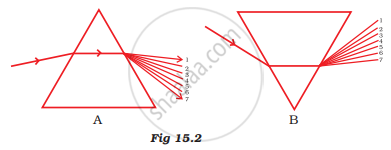Advertisements
Advertisements
Question
How does the speed of light determine the optical density of a medium?
Solution 1
If the speed of light in a medium is less than the speed of light in air, means the MEDIUM is DENSER than air.
If the speed of light is more than the speed of light in AIR, means the MEDIUM is LESS DENSER than air.
Speed of light is 1/density of medium
Solution 2
- Definition of Optical Density: Optical density refers to how much a medium can slow down the speed of light compared to its speed in a vacuum.
- Speed of Light in Different Media: Light travels fastest in a vacuum (c = 3 × 108 m/s). When light enters a medium (like water, glass, or air), its speed decreases depending on the medium's optical density.
- Relation Between Speed and Optical Density: The greater the optical density, the slower the speed of light in the medium. For example, light travels more slowly in glass than in air because glass has a higher optical density.
- Refractive Index: The optical density is quantified using the refractive index (n), which is defined as: `n = c/v`
- Example:
- In air: n ≈ 1, light speed is almost the same as in a vacuum.
- In water: n ≈ 1.33, light slows down significantly.
- In glass: n ≈ 1.5, light slows down even more.
APPEARS IN
RELATED QUESTIONS
What happens when a ray of ordinary light is passed through a triangular glass prism?
What are the seven colours seen in a rainbow?
Which of the following colour of white light is least deviated by the prism?
(a) green
(b) violet
(c) indigo
(d) yellow
The seven colours in the spectrum of sunlight in order, are represented as :
In the spectrum of white light by a prism, the colour at the extreme end opposite to the base of prism is ______.
Say TRUE or FALSE
After passing through a prism, white light splits into a band of seven colours
State the correct sequence (1-7) of colours in the spectrum formed by the prisms A and B, shown in Figure 15.2.

What is Newton’s disc?
During dispersion of white light by prism placed in air, for a particular value of angle of prism,
